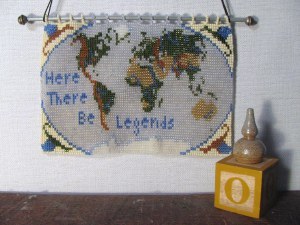The Mapmakers by John Noble Wilford

My own venture in mapmaking
I am far behind on writing reviews for things that I’ve read, I know. But here I am, finally getting around to writing the review for The Mapmakers by John Noble Wilford.
It was long. I’m not sure if that’s because I kept having to scrounge for reading time, or if it’s because the writing was slow, but it felt like I’d been reading it forever. And, looking at the dates I clocked on Goodreads, it does look like it took me two months to read, so I pretty much was reading it forever.
The Mapmakers is a book about the history of maps and map making. It goes all the way back to prehistoric times, and talks about how maps long predate writing, and have been found carved (or painted) on rocks and shells and cave walls and who knows what from tens of thousands of years ago. Which is itself a very interesting fact, since I work with little kids, and there seems to be an assumption that they won’t understand maps, or that they have to be introduced to maps as an idea, and then guided to understanding them. But if mapping predates writing, it’s probably more instinctive than anything. Although the kids I work with do seem to have some troubles with world maps, and keep asking if they live in Germany, or asserting that they live in Mongolia. So perhaps there is some guiding necessary there. But I want to make maps of the playground now, and…oh, but I think we’re a little off topic.
Right. Well, after pre-history, the book talked about how advanced maps were in China and the East, and then came back West and spoke almost exclusively about the Western traditions of mapmaking. Which, honestly, was pretty much what I’d expected, even if it was a bit disappointing.
Medieval maps were interesting because they weren’t intended to be a realistic representation of the world, but instead to be a philosophical interpretation of the layout of the world as created by god. So they don’t really make any geographical sense, but it gives a lot of insight into the way their minds worked.
And then as the world expanded with colonialism and the Age of Exploration, the maps slowly climbed out of philosophy and into reality, but not without a struggle, since there were hypothetical passages, waterways, islands, countries, and even continents, that remained on maps until embarrassingly late in the game.
As the history of mapping became more modern, there was also more information about the surveyors and the mappers themselves, as well as their techniques, and that was interesting to learn about; the struggles they went through, the people they were, and so forth.
It was also interesting to learn about the slow progress of mapping, and how it advanced in fits and starts, and how there were maps from each stage. That was interesting in terms of world-building ideas, since we as authors, almost always assume that the maps our Fantasy characters use are completely accurate and perfect in scale and sense, when, really, given that slice of historical accuracy we all pretend to have, they shouldn’t be.
And I, for one, would not object to more fantasy novels that were about things like mapping the world (through the forest of the Elves, and past the Ice Wyrms, looking for the Mystical City of El Dorantis-La, for example), rather than saving the world from The Biggest Evil EVAR, OMG.
So I enjoyed that much of The Mapmakers. Otherwise, a lot of words were spent talking about the different possible layouts of maps, and how they are mathematically imperfect to illustrate a 3-d almost-sphere on a flat sheet of paper, and other such things. I am not half-bad at math, but I couldn’t follow what he was talking about in the more technical sections, not beyond the very basics, anyway. Same with some of the descriptions of more advanced techniques. Sometimes it just felt like I’d understand if there were a few more illustrations, and other times I just started skimming because there was no way I’d ever get it, unless I was already a mapmaker, probably.
And then the last few chapters were about the changes technology were making to mapping. Which is great, except that this book was written in the early 2000s, you know, before Google Earth and Google Street View existed. Before we landed Curiosity on Mars. Before they launched New Horizons off to map Pluto. So it just all felt really, extremely outdated, and I skipped those chapters, too.
In conclusion…I don’t know. The topic was interesting, and there was lots of information for general purpose or for world-building, but there were also a lot of uninteresting parts to the book, so I’m not sure I’d recommend reading it. I wouldn’t advise against it, but I’d maybe suggest looking into other books on the topic, and seeing if those have better ratings for the layperson to read.





